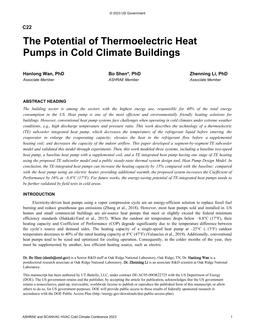
The Potential of Thermoelectric Heat Pumps in Cold Climate Buildings
- Comments Off on The Potential of Thermoelectric Heat Pumps in Cold Climate Buildings
- ASHRAE
Click here to purchase
The building sector is among the sectors with the highest energy use, responsible for 40% of the total energy consumption in the US. Heat pump is one of the most efficient and environmentally friendly heating solutions for buildings. However, conventional heat pump systems face challenges when operating in cold climates under extreme weather conditions, e.g., high discharge temperature and pressure ratio. This work describes the technology of a thermoelectric (TE) subcooler integrated heat pump, which decreases the temperature of the refrigerant liquid before entering the evaporator to enlarge the evaporating capacity; elevates the heat in the refrigerant flow before a supplemental heating coil; and decreases the capacity of the indoor airflow. This paper developed a segment-by-segment TE subcooler model and validated this model through experiments. Then, this work modeled three systems, including a baseline two-speed heat pump, a baseline heat pump with a supplemental coil, and a TE integrated heat pump having one stage of TE heating using the proposed TE subcooler model and a public steady-state thermal system design tool, Heat Pump Design Model. In conclusion, the TE-integrated heat pumps can increase the heating capacity by 15% compared with the baseline; compared with the heat pump using an electric heater providing additional warmth, the proposed system increases the Coefficient of Performance by 16% at –8.8°C (17°F). For future works, the energy-saving potential of TE-integrated heat pumps needs to be further validated by field tests in cold areas.
Product Details
- Published:
- 2023
- Number of Pages:
- 9
- Units of Measure:
- Dual
- File Size:
- 1 file , 4.6 MB
- Product Code(s):
- D-CCC23-22
- Note:
- This product is unavailable in Russia, Belarus

